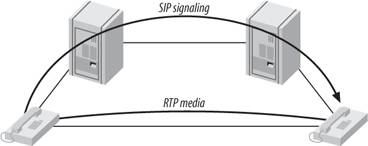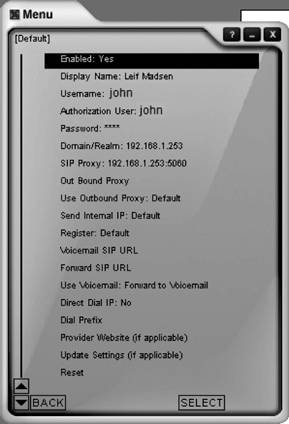4.6. Configuring SIP
The Session Initiation Protocol (SIP), often
used in VoIP phones (either hard phones or soft phones), takes care
of the setup and teardown of calls, along with any renegotiations
during a call. Basically, it helps two endpoints talk to each other
(if possible, directly to each
other). SIP does not carry media; rather, it uses the Real-time
Transport Protocol (RTP) to transfer the media directly between phone A and
phone B once the call has been set up.
4.6.1. SIP and RTP
SIP is an application-layer signaling protocol
that uses the well-known port 5060 for communications. SIP can be
transported with either the UDP or TCP transport-layer protocols.
Asterisk does not currently have a TCP implementation for
transporting SIP messages, but it is possible that future versions
may support it (and patches to the code base are gladly accepted).
SIP is used to "establish, modify, and terminate multimedia
sessions such as Internet telephony calls." SIP does not transport media
between endpoints.
RTP is used to transmit media (i.e., voice)
between endpoints. RTP uses high-numbered, unprivileged ports in
Asterisk (10,000 through 20,000, by default).
A common topology to illustrate SIP and RTP,
commonly referred to as the "SIP trapezoid," is shown in Figure 4-2. When Alice
wants to call Bob, Alice's phone contacts her proxy server, and the
proxy tries to find Bob (often connecting through his proxy). Once
the phones have started the call, they communicate directly with
each other (if possible), so that the data doesn't have to tie up
the resources of the proxy.

SIP was not the first, and is not the only, VoIP
protocol in use today (others include H.323, MGCP, IAX, and so on),
but currently it seems to have the most momentum with hardware
vendors. The advantages of the SIP protocol lie in its wide
acceptance and architectural flexibility (and, we used to say,
simplicity!).
4.6.2. SIP Configuration
Here is a basic sip.conf file:
[general]
context=default
srvlookup=yes
[john]
type=friend
secret=welcome
qualify=yes ; Qualify peer is no more than 2000 ms away
nat=no ; This phone is not natted
host=dynamic ; This device registers with us
canreinvite=no ; Asterisk by default tries to redirect
context=internal ; the internal context controls what we can do
The sip.conf
file starts with a [general] section, which contains the
channel settings and default options for all users and peers defined within sip.conf. You can override the default
settings on a per-user/peer basis by configuring them within the
user/peer definition.
Domain Name System Service records (DNS SRV
records) are a way of setting up a
logical, resolvable address where you can be reached. This allows
calls to be forwarded to different locations without the need to
change the logical address. By using SRV records, you gain many of
the advantages of DNS, whereas disabling them breaks the SIP RFC
and removes the ability to place SIP calls based on domain names.
(Note that if multiple records are returned, Asterisk will use only
the first.) DNS SRV record lookups are disabled by default in
Asterisk, but it's highly recommended that you turn them on. To
enable them, set srvlookup=yes in the [general]
section of sip.conf.
Each connection is defined as a user, peer, or
friend. A user type is used to authenticate incoming
calls, a peer type is used for outgoing calls, and a
friend type is used for both. The extension name is
defined within square brackets ([]). In this case, we have
defined the extension john as a friend.
A secret is a password used for
authentication. Our secret is defined as welcome. We can
monitor the latency between our Asterisk server and the phone with
qualify=yes, thereby determining whether the remote device
is reachable. qualify=yes can be used to monitor any end
device, including other Asterisk servers. By default, Asterisk will
consider an extension reachable if the latency is less than 2,000
ms (2 seconds). You can configure the time Asterisk should use when
determining whether or not a peer is reachable by replacing
yes with the number of milliseconds.
If an extension is behind a device performing
Network Address Translation (NAT), such as a router or firewall,
configure nat=yes to force Asterisk to ignore the contact
information for the extension and use the address from which the
packets are being received. Setting host=dynamic will
require the extension to register so that Asterisk knows how to
reach the phone. To limit an endpoint to a single IP address or
fully qualified domain name (FQDN) ,
replace dynamic with the IP address or domain name. Note
that this limits only where you place calls to, as the user is allowed to place calls
from anywhere (assuming she has
authenticated successfully). If you set host=static, the
end device is not required to register.
We've also set canreinvite=no. In SIP,
invites are used to set up calls
and to redirect media. Any invite issued after the initial invite
in the same dialog is referred to as a reinvite. For example, suppose two parties are
exchanging media traffic. If one client goes on hold and Asterisk
is configured to play Music on Hold (MoH), Asterisk will issue a
reinvite to the secondary client, telling it to redirect its media
stream toward the PBX. Asterisk is then able to stream music or an
announcement to the on-hold client.
The primary client
then issues an off-hold command in a reinvite to the PBX, which in
turn issues a reinvite to the secondary party requesting that it
redirect its media stream toward the primary party, thereby ending
the on-hold music and reconnecting the clients.
Normally, when two endpoints set up a call they
pass their media directly from one to the other. Asterisk generally
breaks this rule by staying within the media path, allowing it to
listen for digits dialed on the phone's keypad. This is necessary
because if Asterisk cannot determine the call length, inaccurate
billing can occur. Configuring canreinvite=no forces
Asterisk to stay in the media path, not allowing RTP messages to be
exchanged directly between the endpoints.
Asterisk will not issue a reinvite in any of the
following situations:
-
If either of the clients is configured with
canreinvite=no
-
If the clients cannot agree on a common set of
codecs and Asterisk needs to perform codec conversion
-
If either of the clients is configured with
nat=yes
-
If Asterisk needs to listen to Dual Tone
Multi-Frequency (DTMF) tones during the call (for transfers or any
other features)
Lastly, context=internal specifies the
location of the instructions used to control what the phone is
allowed to do, and what to do with incoming calls for this
extension. The context name configured
in sip.conf matches the name of
the context in extensions.conf,
which contains the instructions. More information about contexts
and dialplans will be presented in the following chapter.
If you are configuring a number of clients with
similar configurations, you can place like commands under the
[general] heading. Asterisk will use the defaults
specified in the [general] section unless they are
explicitly changed within a client's configuration block.
4.6.3. Client Configuration
While it would be impossible to show all the
possible configurations for all the end devices that can
communicate with Asterisk, we feel it beneficial to provide the
configuration for at least one free soft phone, which you can use
in determining if Asterisk is right for your organization. We've
chosen to use X-ten's X-Lite client ,
which you can download from their web site (http://www.xten.com).
The configuration of the client is generally
straightforward. The most important parts are the username and
password for registration, plus the address of the Asterisk server
with which you wish to register. Figure 4-3 shows a sample configuration
for the X-Lite client. Be sure to modify the values of the fields
to reflect your configuration.

The display name is the string that will be used
for Caller ID. The username and authorization user are used for
authentication, along with the password. The domain/realm should be
the IP address or FQDN of your Asterisk server. The SIP proxy is the same as the one entered for the
domain/realm, but with :5060 appended (this specifies the
port number to use for SIP signalingbe sure it matches the port you
have configured in sip.conf).
After entering all this information, verify that
Enabled is set to Yes, and then close the
configuration menu. X-Lite will then register to Asterisk. If
X-Lite doesn't appear to register, simply restart the client.
Because X-Lite is minimized to the task tray when you close the
application with the X button, you will need to exit the program by
right-clicking on the icon in the tray and then clicking "Exit" in
the pop-up menu before restarting.
4.6.4. Dialplan Configuration
Many SIP phones, both soft and hard, are
multi-line phones. This means they can accept multiple incoming
calls at the same time. Thus, to test your X-Lite soft phone you
can simply call yourself, and the call will loop back from the
Asterisk server and onto line two of the client. To call yourself,
dial extension 100. If your preferred client doesn't support
multi-line functionality, you can use extension 611 to enter the
Echo( ) test application.
[internal]
exten => 100,1,Dial(SIP/john)
exten => 611,1,Echo( )
 |

